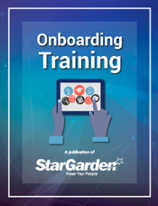5 things to include in an effective employee training program

Before you begin training new employees, it’s essential to figure out exactly what that training will encompass. Trying to just let new hires “follow along” with a job position and pick up what they need to know is ineffective, frustrating for both the new employee and the employees tasked with babysitting, and a drain on your company’s resources. Effective training depends on organization and planning. Laying out what information you need to communicate is the first step.
This will likely include:
1. Legal requirements.
Depending on your jurisdiction and your industry, you must provide all employees with information regarding applicable laws governing wages, working conditions, safety, privacy, anti-discrimination, and more. Know what requirements apply to your new employees and how you will disseminate that information to them.
Examples include HIPAA privacy policies, OSHA safety requirements, and break and overtime requirements. Have each employee record an acknowledgement that he or she has received and understands each document.
2. Company policies.
Your company likely has internal policies, such as employee handbooks, codes of conduct, confidentiality agreements, etc. Organize these documents and policies into one module or handout to ensure they reach each new hire.
Making these documents available in an online system can ensure that every employee has access to the most-current version of each policy. Encourage or require your employees to periodically enter the system and review the existing or updated policies.
3. Job duties.
Obviously, each new employee will need to learn the specifics of the job he or she was hired for. This will usually be the bulk of the training process, including where and when to work, on which projects or jobs, and with whom.
In addition to a worker’s actual job duties, ensure that he or she knows where to find the resources he or she needs. Providing employees with building/office/jobsite maps, phone lists, and other reference guides can help them hit the ground running.
4. Company culture.
Entering a new workplace can feel alienating: many employees already have established friendships. Helping new employees feel welcome and form relationships with their coworkers can help employee engagement (and ultimately, job satisfaction and retention).
Letting employees in on “unspoken” company policies can help prevent accidental embarrassment or discomfort. These can include traditions like “casual Friday” or regularly going out for happy hour at the end of the work day, as well as customs like whether it’s acceptable to “knock and enter” when a door is closed. (One employee only realized this was the policy the third time someone knocked and then walked in while she was changing clothes in her office for a lunchtime run!)
Having another employee or their manager take the new employee for coffee or lunch the first day is also a good way to make them feel included.
5. Client or vendor introductions.
New employees can also feel overwhelmed when they are assigned to projects without being introduced to any of the clients, vendors, or other important outside contacts. Helping to arrange introductions with those key players can ensure a smoother transition for the new employee’s work on that project.
Plus, personally introducing new team members to outside contacts shows everyone that you value the relationship and allows them to comfortably get more familiar with each other.
Once you’ve figured out what you need to communicate to new employees, you can start to figure out how to best transmit that information, who would be best to do so, and how long it will take.
StarGarden can help you build the workflow solutions you need to streamline your employee training and onboarding system. Download our complimentary eBook for more tips on effectively training new hires by clicking the link below, and contact us today if you’d like more information on how an integrated HCM software system can help your business thrive!

